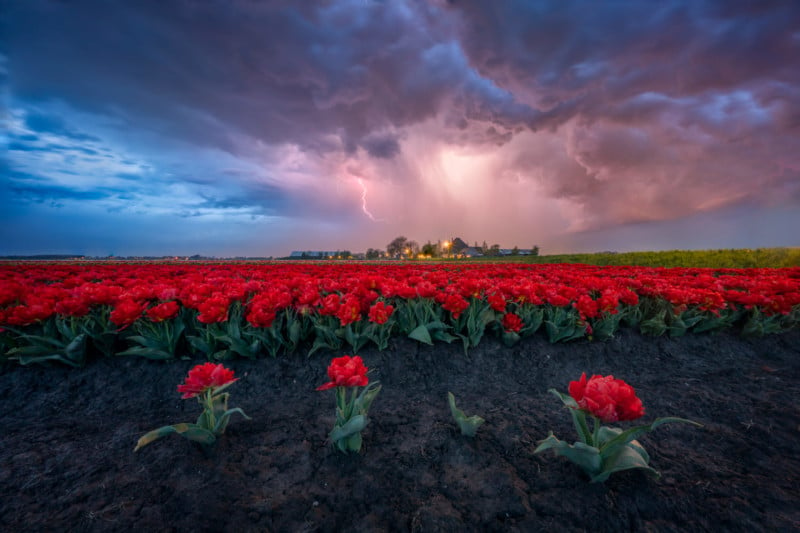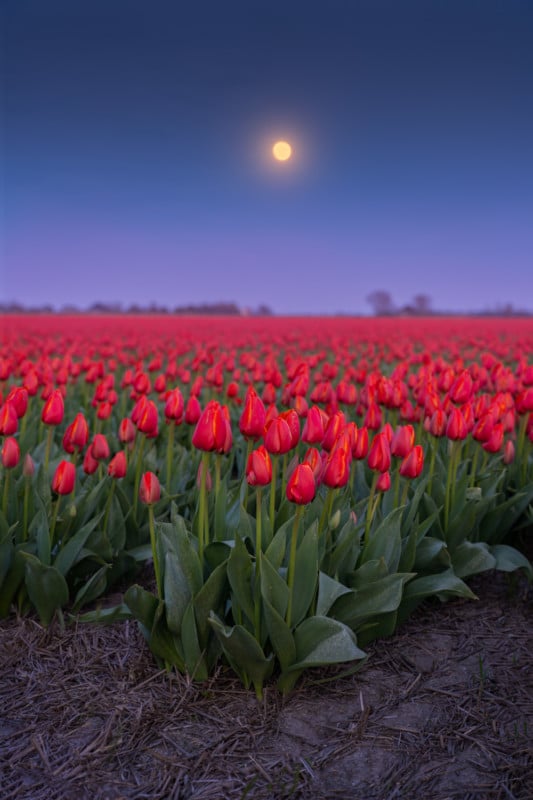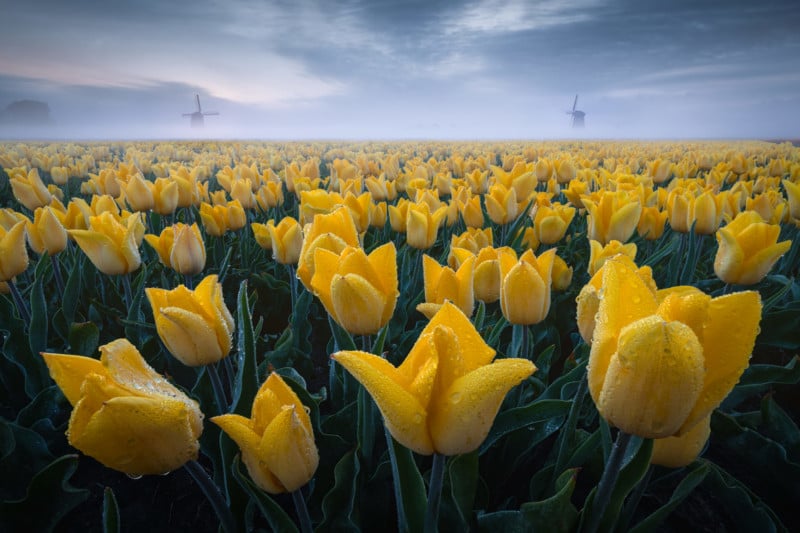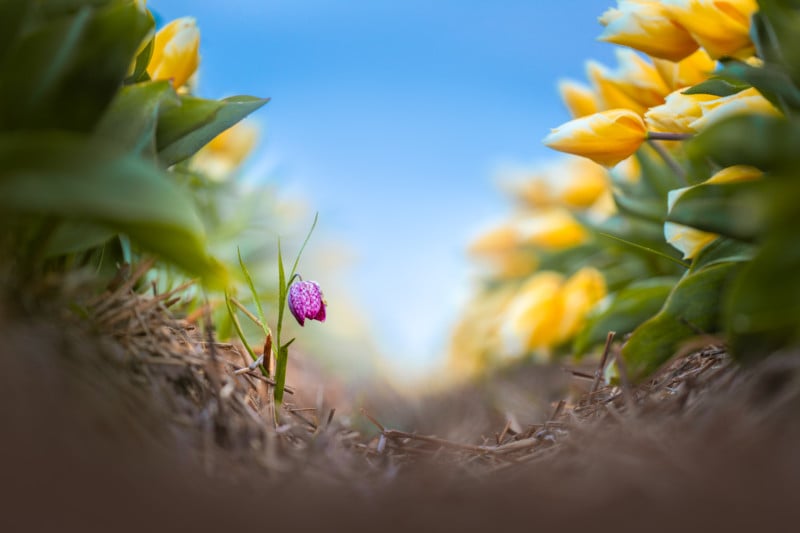How to Photograph Tulips in the Netherlands
![]()
I always enjoy tulip season in the Netherlands. As a landscape photographer from the Netherlands, I have been photographing them and writing about them for many years from every possible angle. In this article, I will share a guide with tips on how you can shoot Dutch tulip season for yourself.
Unfortunately, many tulip growers had to take action and put fences around their fields and actively protect them from tourists ‘destroying’ their fields. The sad truth is that there are a lot of people (definitely not everyone) that have no respect for the tulip fields, stand on the flowers while taking selfies, and even take the flowers from the fields.
I would normally end my article with this, but I feel it deserves extra attention today: Respect the growers’ fields! More on this later.
As a local photographer who has been photographing the fields for many years, I have made friends with tulip growers (of PolderPride and other local grower companies). I enjoy seeing them every year and taking beautiful photos of their tulip fields. When I photograph the fields, I always make sure I am careful. And when I enter the fields, it is with their permission.
Tips for Photographing Tulips
Now let’s get to the fun stuff because photographing tulips and flowers is fun! There are lots of different angles and conditions to photograph tulips in. Here is some inspiration:
Use the Obvious Leading Lines
The easiest way is to just use the leading lines of the tulips in your composition. These images always work well and are very simple to photograph. Make sure you turn on the grid on your camera. This way, you make sure that the lines are perfectly going through the exact middle of the image.

Photograph With Lots of Different Conditions
Of course, a spectacular sunset or sunrise is beautiful around the tulip fields. But dark skies, storms, and even a blue sky with puffy clouds look beautiful above the tulip fields. There’s really always something to photograph on the fields!

Use a Drone
Photographing with a drone gives you a different perspective. Top-down views can give very beautiful abstract images of tulip fields. Just make sure you’re allowed to fly at the field. It’s not allowed in every area in the Netherlands.
![]()
Use Complimentary and Contrasty Colors
A tulip field often has many rows of different colors of tulips. You can use that to your advantage if you want to match the tulips to the color of the sky. Bright red tulips work well with a dark blue sky for example.

Use a Little Bit of a Higher ISO
It can get windy in the Netherlands. To make sure the flowers are sharp, you often have to use a slightly higher ISO (especially when photographing at sunset or sunrise) to make sure the tulips are sharp.
![]()
Portrait Orientation
Experiment with portrait orientation. Don’t only shoot in landscape mode. Portrait orientation can occasionally give more depth and layers to an image.
![]()
Get Super Close and Use Focus Stacking
You can get very low and close to the flowers. It takes some time to find “the perfect tulip” in the foreground, but it can be very rewarding when you do. With this technique, your image will look very 3D. You get so close to the tulip in the foreground that you can’t get everything in focus. Basically, you’re near the maximum focus distance of your lens.
If you can’t get both the foreground and background in focus, you can use a technique called “focus stacking.” With this, you take a photo of the foreground, mid-ground, and background, and merge them together in postprocessing to get a sharp photo from front to back. Note that this technique can only be done with basically no wind.
Note: I also teach this postprocessing technique in my editing course.

Find Interesting Tulips That Stand Out and Take Close-ups
Closely walk past the rows of tulips and see which ones stand out. And try to take a photo of them with a telephoto lens. I sometimes even use 400mm and get quite far away. This way you can take a super dreamy image of a single tulip. Of course, you can also use a macro lens. Fun fact: While the tulips that stand are beautiful, they are usually “sick.” The tulip growers all remove them from the fields before they do their harvest.

Get Closer for Details of the Flowers
Get even closer to capture the tiny details of the flowers. You can get super close with a macro or telephoto lens to photograph the little details of the tulips. Dewdrops in the morning for example, or simply the elegant shapes and colors of the flowers. Sometimes I can spend an hour photographing a single tulip from all angles.
![]()
![]()
When Do You Find Tulips in the Netherlands?
If you visit half April you’re usually good to go. We can never be sure when the first tulips pop up, and different parts of the country blossom at different times. The tulips weeks early or weeks later depending on the weather of the season. As it’s quite warm at the beginning of this year, we’re currently expecting to see the first tulips at the beginning of April or maybe even a little bit earlier.
Where Are the Most Beautiful Dutch Tulip Fields?
This is a question I get asked a lot and the truth is: I can never give an exact location. The tulip fields are always different every year. Of course, there are areas in the country with a lot of tulip fields, but you’ll have to check them out every year to see what exact field looks the best. They also often slightly change, as it’s difficult the grow the same flower on the same field for multiple years in a row. That could mean that you have a beautiful tulip field right in front of a windmill in one year, but it won’t be there the next.
I wrote an article in 2017 about some areas of the Netherlands where you can find tulips. Those locations haven’t changed much. There is also a tulip route in the Noord Oostpolder of the country, which is a designated route with tulip fields that you can drive by car. I would recommend doing that if you don’t know where to start.
![]()
Rules to Follow When Shooting Tulips
I’d like to conclude this article by referring back to the beginning. Photographing tulips is great, but keep in mind that you’re on someone’s property.
DON’T access tulip fields that have a fence around them. That fence is there for a reason.
DON’T walk into the tulip fields when you don’t have permission from the tulip grower. Sometimes they’re working on their land. If you see people working, simply walk up to them and ask who’s the owner of the field. This is how I made friends over the years. I love to chat with the growers about their flowers. They always talk with passion. Then simply ask if they don’t mind that you’re taking some photos of their flowers. Ask their email address and email them some of your photos. This way you’ll always be welcome in their fields.
DON’T take flowers from the fields. They’re not yours!
DO always be careful when walking in the fields (with permission). Treat the field like it’s your own garden. Respect the fields.
DO take beautiful photos!
In Conclusion
Photographing the tulips is different each year. Different conditions, different flowers (did you know they come up with completely new tulips every year?), different weather, different fields. I can really never get bored of photographing the tulips! Let’s all stick to the rules and be nice to our tulip growers. And enjoy the beauty and the smell of these beautiful flowers!
P.S. If you’re interested in how I edit all of my photography (including lessons on how to edit tulip & flower photos), please check out my Full Editing Course on Landscape Photography.
About the author: Albert Dros is an award-winning Dutch photographer. The opinions expressed in this article are solely those of the author. His work has been published by some of the world’s biggest media channels, including TIME, The Huffington Post, The Daily Mail, and National Geographic. You can find more of his work on his website, or by following him on Facebook and Instagram. This article was also published here.